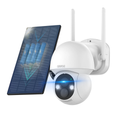The Evolution of Video Surveillance Systems: Tracing the OHWOAI Perspective
In this era of relentless technological advancement, video surveillance has seamlessly woven itself into the fabric of our lives, gradually transcending from bustling public spaces to the serene confines of our homes. The widespread embrace of video surveillance systems is rooted in their multifaceted security features, notably safeguarding individuals and communities. Echoing the ancient Chinese proverb, "Seeing is believing," these systems substantiate our safety concerns with tangible visual evidence. But let's delve deeper into the genesis and evolution of video surveillance systems, unraveling the stages they've traversed and the remarkable transformation they've undergone.
**Unveiling the Developmental History of Video Surveillance Systems**
In the current landscape, video surveillance has truly become ubiquitous, making an indelible mark on both public and private domains. Its far-reaching adoption hinges on the comprehensive assurance it imparts, particularly when it comes to security. As the adage goes, "Seeing is believing," and video surveillance aligns seamlessly with this innate human need for visual affirmation. But how exactly did video surveillance systems emerge, and what milestones have they crossed on their evolutionary journey?
**The First Generation of Video Surveillance Systems**
The initial phase of video surveillance systems entails the epoch of traditional analog monitoring. This era centered around matrix-driven setups, featuring analog cameras, dedicated video cables, switching matrices, monitors, analog recording equipment, and cassette tapes. These systems were designed to fulfill the need for localized and short-range surveillance.
**Key Features**:
- Video signals were captured, transmitted, and stored in analog format, boasting commendable quality.
- Over the span of several decades, the relevant technology had matured, manifesting its stability.
However, this generation bore certain limitations:
- Coverage and transmission distance were constrained, effectively precluding remote management and access.
- Expanding and enhancing the system proved to be a formidable task, with soaring costs.
- Extensive reliance on cassette tape storage and manual queries resulted in intricate management and maintenance.
- Integration with other security systems was virtually untenable.
**The Second Generation of Video Surveillance Systems**
The subsequent phase introduces the reign of the digital realm, epitomized by the ascendancy of digital video recorders (DVRs). This era, constituting a semi-digital surveillance epoch, ingeniously harnessed the prowess of computer technology to endow users with a user-centric viewing and management experience. It adeptly resolved challenges that analog matrix technology was ill-equipped to address, thus representing an extension of the first-generation capabilities.
**Key Features**:
- Video and audio signals were captured and stored in digital format, ensuring unparalleled quality.
- The embrace of digital storage significantly augmented users' processing and querying capacities concerning recorded data.
- Backward compatibility facilitated seamless upgrades and transformations for first-generation analog monitoring products.
- Networked DVR functionalities and optical transceivers triumphed over long-distance video transmission impediments, aptly addressing the pressing demand for extensive-range surveillance and video resource dissemination.
- The advent of embedded DVR systems elevated reliability and simplified installation, catalyzing their widespread adoption.
The maturation of DVR technology hastened the trend toward civilian video surveillance, ushering in an era of prolific application. However, these advancements also unveiled some inherent shortcomings:
- DVR systems still bore the imprint of first-generation analog monitoring approaches, entailing analog transmission from monitoring points to central hubs. This necessitated the intricate process of laying cables or optical fibers, leading to escalated construction costs and maintenance intricacies.
- Limited standalone capacity rendered DVR systems unsuitable for centralized recording within large-scale configurations, thereby complicating unified record management.
- Limited network functionalities hindered comprehensive management and complex maintenance within sprawling applications.
**The Third Generation of Video Surveillance Systems**
As the journey progresses, we arrive at the zenith of video surveillance evolution—the age of full-digital video surveillance, epitomized by front-end network video. This phase champions the digitization of video signals from their point of origin and leverages networks as transmission conduits. The result is seamless online video transmission, underpinned by functional control hosts online, offering comprehensive browsing, control, and storage capabilities for the entire surveillance ecosystem.
**Key Features**:
- Characterized by a modular structure, this phase embodies heightened flexibility and scalability, accommodating diverse network topologies.
- An economical, high-efficiency infrastructure simplifies management hierarchies and conserves significant cable resources.
- Installation and maintenance are rendered seamless, fostering diverse solution offerings.
- Lossless video exchange, replication, and storage break the shackles of distance, as network connectivity translates to immediate access.
- Capitalizing on the maturity of TCP/IP network technology, this phase offers a plethora of access methodologies.
- Seamless integration with existing and nascent applications fosters unified multi-network operations.
In the current landscape, the third generation finds the most extensive application. However, the first and second generations still find their niche in certain domains. The trajectory of video surveillance is one of evolution, innovation, and an unwavering commitment to safety and security. As a frontrunner in the surveillance industry, OHWOAI envisions the future with smarter, more integrated, and seamlessly connected video surveillance solutions, redefining the way we perceive security and experience our environments.
Sample Block Quote
Nam tempus turpis at metus scelerisque placerat nulla deumantos sollicitudin delos felis. Pellentesque diam dolor an elementum et lobortis at mollis ut risus. Curabitur semper sagittis mino de condimentum.










